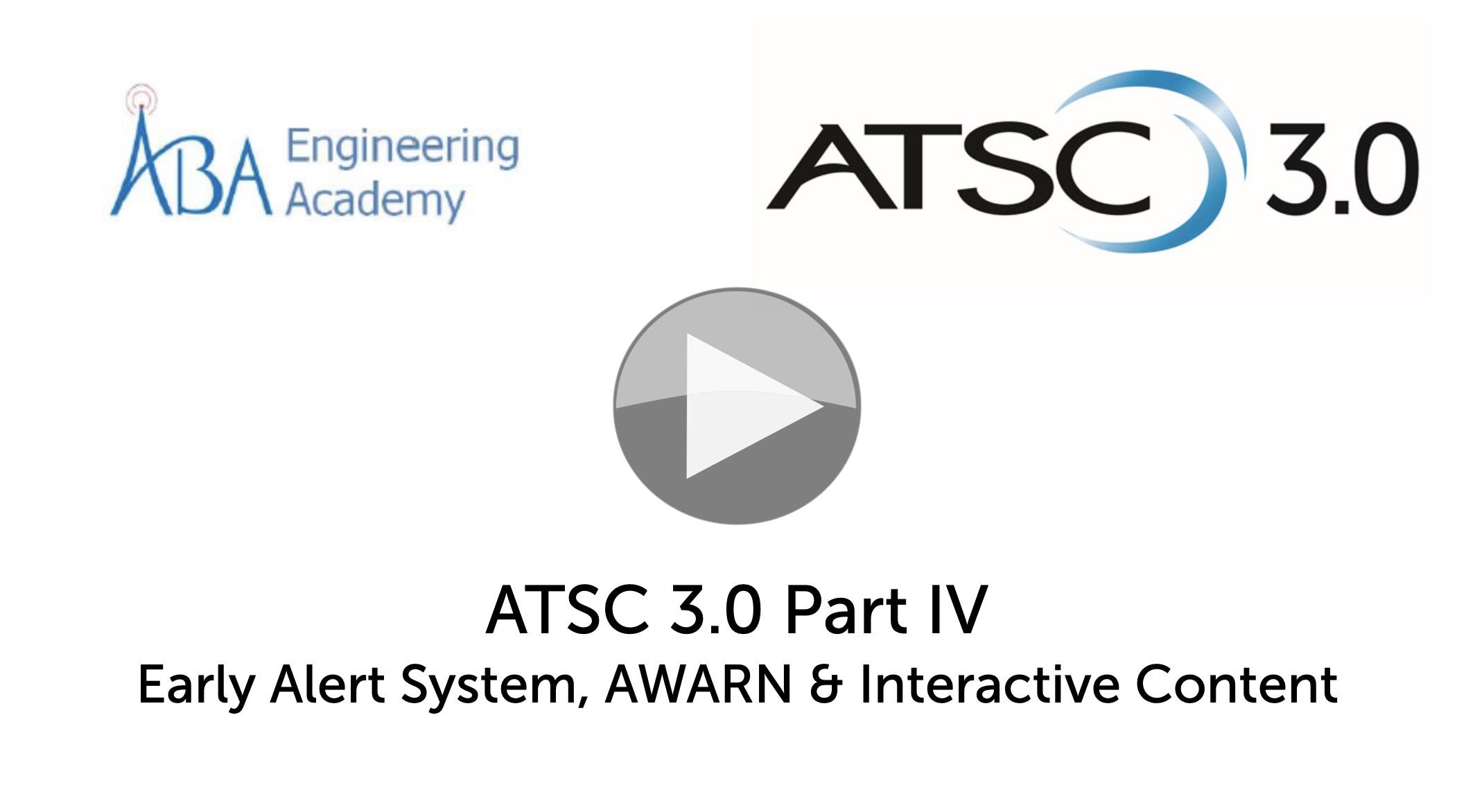
ATSC3.0 is an innovative set of standards that gets closer to the maximum possible throughput, AKA the Shannon limit, than 5G and previous technologies. So flexible a technology it is that it allows convergence with 5G networks, itself in the form of an SFN and inter-transmitter links as well as a seamless handoff for receivers between the internet and the broadcast transmission. ATSC 3.0 is an IP-based technology that is ready to keep up to date with changing practices and standards yet leave viewers to experience the best of broadcast RF transmission, wireless internet and broadband without having to change what they’re doing or even know which one(s) they’re watching.
This SMPTE event looks at a number of ATSC’s innovations, moderated by SMPTE Toronto section chair, Tony Meerakker and kicks off with Orest Sushko from the Humber Broadcast-Broadband Convergence Lab development in Toronto. This is a Canadian initiative to create an environment where real-world ATSC 3.0 testing can be carried out. It’s this type of lab that can help analyse the applications talked about in this video where different applications are brought into a broadcast RF environment including integration with 5G networks. It will also drive the research into ATSC 3.0 adoption in Canada.
Next is the ATSC president, Madeleine Noland, who introduces what ATSC 3.0 is and why she feels its such an innovative standards suite. Created by over 400 engineers throughout the world, Madeleine says that ATSC 3.0 is a state of the art standard with the aims to add value to the broadcast service with the idea that broadcast towers are ‘not just TV anymore. This idea of blurring the lines between traditional RF transmission and other services continues throughout this series of talks.
The aim of ATSC 3.0 is to deliver all television over IP, albeit it uni-directional IP. It also uses a whole stack of existing technologies at the application layer such as HTML5, CSS and JavaScript. These are just three examples of the standards on which ATSC 3.0 is based. Being based on other standards increases the ability to deploy quickly. ATSC 3.0 is a suite of tens of standards that describe the physical layer, transport, video & audio use, apps and more. Having many standards within is another way ATSC 3.0 can keep up with changes; by modifying the relevant standards and updating them but also not being afraid of adding more.
Madeleine says that 62 market areas will be launching which bring the reach of ATSC 3.0 up to 75% of the households in the US under the banner ‘NextGen TV’ which will act as a logo signpost for customers on TVs and associated devices. ATSC 3.0 exists outside the US in Korea where 75% of the population can receive ATSC 3.0. Canada is exploring, Brazil is planning, India’s TSDSI is researching and many other countries like Australia are also engaging with the ATSC to consider their options for national deployment against, presumably DVB-I.
The last point in this section is that when you convert all your transmitters to IP it seems weird to have just a load of ‘node’. Madeleine’s point is that a very effective mesh network could be created if only we could connect all these transmitters together. These could then provide some significant national services which will be discussed later in this video.
Interactive TV
Mark Korl is next talking about his extensive work creating an interactive environment within ATSC 3.0. The aim here was to enhance the viewer/user experience, have better relationships with them and provide an individualised offering including personalised ads and content.
Mark gives an overview of A/244, ATSC 3.0 Interactive Content and ATSC 3.0 standard A/338 talking about signalling, delivery, synchronisation and error protection, service announcement such as EPG, content recovery in redistribution scenarios, watermarking, Application event delivery, security and more.
Key features of interactivity are the aforementioned use of HTML 5, CSS and JavaScript to create seamless and secure delivery of interactive content from broadcast and broadband. Each application lives in its own separate context and features are managed via API.
Mark finishes by outlining the use of the Emergency Advanced Emergence informAtion table which signals everything the receiver needs to know about the AEA message and associated rich media and then looks at how, at the client, content/ads can be replaced by manipulating the .mpd manifest file with locally-downloaded content using XLink references.
Innovateive technologies implemented in ATSC 3.0
Dr. Yiyan Wu takes the podium next explaining the newest RF-based techniques used in ATSC 3.0 which are managing to get ATSC3.0 closer to the Shannon limit than other similar contemporary technologies such as 4F and 5G New Radio (NR). These technologies are such as LDPC – Low Dennsity Parity Codes – which have been in DVB-S2 and DVB-T2 for a long time but also Non-Uniform Constellations such as 4096NUC-QAMas well as Canada-invented Layered-Devision-Multiplexing (LDM) that can efficiently combine robust mobile and high-datarate service on top of each other on a single TV channel. This works by having a high-power, robust-coded signal with a quieter signal underneath which, in good situations, can still be decoded. The idea is that the robust signal is the HD transmitted with HEVC SVC (Scalable Video Coding) meaning that the UHD layer can be an enhancement layer on top of the HD. There is no need to send the whole UHD signal. Dr. Yuyan Wu finishes this section by explaining the LDM offers reduced Tx and Rx power.
Using LDM, however, we’re actually creating more bandwidth than we had before. Dr. Wu points out that this can be used for improved services or be used for an in-band distribution link, i.e. to move live video down through a network of transmitters. While not necessary the fact that an ATSC 3.0 transmitter can operate as part of a single frequency network is very useful as a weak signal from one transmitter can be boosted by the signal from another.
Dr. Wu spends time next talking about 5G use cases detailing the history of failed attempts at ‘broadcast’ versions of 3G, 4G and LTE. With 5G USPs such as network slicing, the current version of the broadcast mode of 5G is more likely than ever to be commercially implemented. Called 5G feMBMS, it’s actually a 4G/LTE-based technology for delivery over a 5G network.
One plan for 5G integration, which is possible as ATSC 3.0 has the same timing reference as 5G networks, is for 5G networks to spot when thousands of people are watching the same things and move that traffic distribution over to the ATSC 3.0 towers who can do multicast would an issue.
Next Gen commercialisation update
Last in the video we have Anne Schelle who works with the ATSC as a board chair of the ATSC 3.0 Security Alliance. She explains that the number of markets announcing for deployment in 2021 is twice that of 2020. Deployment of ATSC 3.0 is going well, the most common initial use has been to test interactive services. The projected TV shipping numbers with ATSC 3.0 internally are positive and, Anne says, the economics for NextGen receiver inclusion is better than it has been previously. Speaking from her security perspective, having in-built content security protection is new for broadcasters who welcome it as it helps reduce piracy
Watch now!
Speakers
 |
Madeleine Noland
President,
ATSC
|
 |
Mark Corl
Chair ATSC S38 Specialist Group on Interactive Environment
SVP Emergent Technology Development, Triveni Digital
|
 |
Dr. Yiyan Wu
Principal Research Scientist,
Communications Research Centre Canada (CRC)
|
 |
Anne Schelle
Board chair of ATSC 3.0 Security Alliance
Board Member, ATSC
Managing Director, Pearl TV
|
 |
Orest Sushko
Project Lead, Humber Broadcast-Broadband Conergence Lab
Program Coordinator, Film & Multiplatform Storytelling Program, Humber College
|
 |
Moderator: Tony Meerakker
Chair, SMPTE Toronto Section
Consultant, Meer Tech Systems |





















